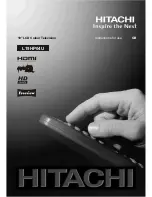
English
- 3 -
Power Source
The TV set should be operated only from a 220-240
V AC, 50 Hz outlet. Ensure that you select the correct
voltage setting for your convenience.
Power Cord
Do not place the set, a piece of furniture, etc. on the
power cord (mains lead) or pinch the cord. Handle the
power cord by the plug. Do not unplug the appliance
by pulling from the power cord and never touch the
power cord with wet hands as this could cause a short
circuit or electric shock. Never make a knot in the cord
or tie it with other cords. The power cords should be
placed in such a way that they are not likely to be
stepped on. A damaged power cord can cause fi re or
give you an electric shock. When it is damaged and
needs to be replaced, it should be done by qualifi ed
personnel.
Moisture and Water
Do not use this device in a humid and
damp place (avoid the bathroom, the
sink in the kitchen, and near the washing
machine). Do not expose this device to
rain or water, as this may be dangerous
and do not place objects fi lled with liquids,
such as fl ower vases, on top. Avoid from
dripping or splashing.
If any solid object or liquid falls into the cabinet, unplug
the TV and have it checked by qualifi ed personnel
before operating it any further.
Cleaning
Before cleaning, unplug the TV set
from the wall outlet. Do not use liquid or
aerosol cleaners. Use soft and dry cloth.
Ventilation
The slots and openings on the TV set are intended for
ventilation and to ensure reliable operation. To prevent
overheating, these openings must not be blocked or
covered in anyway.
Heat and Flames
The set should not be placed near to open
fl ames and sources of intense heat such
as an electric heater. Ensure that no open
fl ame sources, such as lighted candles,
are placed on top of the TV. Batteries
should not be exposed to excessive heat
such as sunshine, fi re or the like.
Lightning
Before a storm and lightning or when going
on holiday, disconnect the power cord and
aerial lead from the wall sockets.
DON’T
remove any fi xed cover as this may expose
dangerous voltages.
DON’T
obstruct the ventilation openings of the
equipment with items such as newspapers, tablecloths,
curtains, etc. Overheating will cause damage and
shorten the life of the equipment.
DON’T
allow electrical equipment to be exposed to
dripping or splashing, or objects fi lled with liquids, such
as vases, to be placed on the equipment.
DON’T
place hot objects or naked fl ame sources
such as lighted candles or nightlights on, or close to
equipment. High temperatures can melt plastic and
lead to fi res.
DON’T
use makeshift stands and
NEVER
fi x legs
with wood screws - to ensure
complete safety always fit the manufacturer’s
approved stand or legs with the fi xings
provided according to the instructions.
DON’T
use equipment such as personal stereos or
radios so that you are distracted from
the requirements of traffi c safety. It is illegal to watch
television whilst driving.
DON’T
listen to headphones at high volume, as such
use can permanently damage your
hearing.
DON’T
leave equipment switched on when it is
unattended unless it is specifi cally stated
that it is designed for unattended operation or has a
stand-by mode. Switch off using the
switch on the equipment and make sure that your
family know how to do this. Special
arrangements may need to be made for infi rm or
handicapped people.
DON’T
continue to operate the equipment if you are
in any doubt about it working
normally, or if it is damaged in any way - switch off,
withdraw the mains plug and consult
your dealer.
ABOVE ALL
--- NEVER let anyone especially children
push anything into holes, slots or any other
opening in the case - this could result in a
fatal electrical shock;
--- NEVER guess or take chances with
electrical equipment of any kind
--- it is better to be safe than sorry!
*************





































